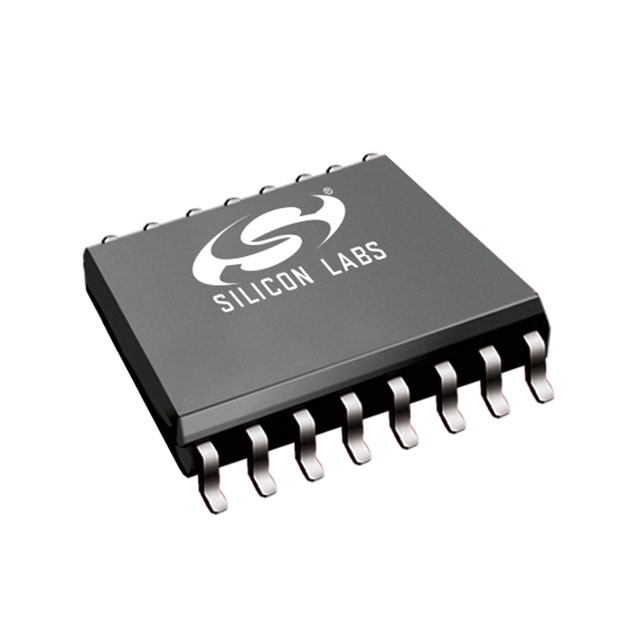Consulte las especificaciones para obtener detalles del producto.

C8051F826-GS
Product Overview
Category
The C8051F826-GS belongs to the category of microcontrollers.
Use
This microcontroller is commonly used in various electronic devices and systems for controlling and processing data.
Characteristics
- High-performance 8-bit microcontroller
- Low power consumption
- Integrated peripherals for enhanced functionality
- Flexible and versatile design
- Robust and reliable performance
Package
The C8051F826-GS is available in a compact and industry-standard package, making it suitable for easy integration into different applications.
Essence
The essence of the C8051F826-GS lies in its ability to provide efficient control and processing capabilities in a wide range of electronic systems.
Packaging/Quantity
This microcontroller is typically packaged in trays or reels, with varying quantities depending on the manufacturer's specifications.
Specifications
- Architecture: 8-bit
- CPU Speed: Up to 25 MHz
- Flash Memory: 8 KB
- RAM: 256 bytes
- Operating Voltage: 2.7V to 3.6V
- I/O Pins: 16
- ADC Channels: 8
- Communication Interfaces: UART, SPI, I2C
- Timers/Counters: 2
- Operating Temperature Range: -40°C to +85°C
Detailed Pin Configuration
The C8051F826-GS features a total of 16 pins, each serving a specific purpose. The pin configuration is as follows:
- P0.0 - GPIO / ADC0
- P0.1 - GPIO / ADC1
- P0.2 - GPIO / ADC2
- P0.3 - GPIO / ADC3
- P0.4 - GPIO / ADC4
- P0.5 - GPIO / ADC5
- P0.6 - GPIO / ADC6
- P0.7 - GPIO / ADC7
- P1.0 - GPIO / UART TX
- P1.1 - GPIO / UART RX
- P1.2 - GPIO / SPI MOSI
- P1.3 - GPIO / SPI MISO
- P1.4 - GPIO / SPI SCK
- P1.5 - GPIO / I2C SDA
- P1.6 - GPIO / I2C SCL
- P1.7 - GPIO
Functional Features
- High-speed processing capabilities
- Integrated analog-to-digital converter (ADC)
- Multiple communication interfaces for data exchange
- Flexible general-purpose input/output (GPIO) pins
- Timers and counters for precise timing operations
- Low-power modes for energy efficiency
- On-chip debugging support
Advantages and Disadvantages
Advantages
- Efficient performance in a wide range of applications
- Versatile and flexible design for easy integration
- Low power consumption for extended battery life
- Integrated peripherals reduce external component count
- On-chip debugging simplifies development and troubleshooting
Disadvantages
- Limited flash memory capacity compared to higher-end microcontrollers
- Restricted number of I/O pins for larger-scale projects
- Relatively higher cost compared to some entry-level microcontrollers
Working Principles
The C8051F826-GS operates based on the principles of digital logic and microcontroller architecture. It executes instructions stored in its flash memory, processes data, and controls various peripheral devices connected to it. The microcontroller communicates with external components through its I/O pins and utilizes its integrated peripherals to perform specific tasks.
Detailed Application Field Plans
The C8051F826-GS finds application in various fields, including but not limited to:
- Industrial automation
- Consumer electronics
- Internet of Things (IoT) devices
- Home automation systems
- Medical equipment
- Automotive electronics
Detailed and Complete Alternative Models
- C8051F820-GS
- C8051F824-GS
- C8051F828-GS
- C8051F830-GS
- C8051F832-GS
These alternative models offer similar functionality and performance characteristics, providing options for different project requirements.
Word count: 540 words
Enumere 10 preguntas y respuestas comunes relacionadas con la aplicación de C8051F826-GS en soluciones técnicas
Sure! Here are 10 common questions and answers related to the application of C8051F826-GS in technical solutions:
Q1: What is C8051F826-GS? A1: C8051F826-GS is a microcontroller from Silicon Labs' C8051F82x family, designed for embedded applications.
Q2: What are the key features of C8051F826-GS? A2: Some key features include an 8-bit MCU core, 16 kB Flash memory, 512 bytes RAM, multiple communication interfaces, analog peripherals, and low power consumption.
Q3: What technical solutions can C8051F826-GS be used for? A3: C8051F826-GS can be used in various technical solutions such as industrial automation, consumer electronics, smart home devices, IoT applications, and more.
Q4: How can I program C8051F826-GS? A4: C8051F826-GS can be programmed using the Silicon Labs IDE (Integrated Development Environment) called Simplicity Studio, which supports C programming language.
Q5: Can C8051F826-GS communicate with other devices? A5: Yes, C8051F826-GS has multiple communication interfaces including UART, SPI, and I2C, allowing it to communicate with other devices or peripherals.
Q6: Does C8051F826-GS support analog inputs? A6: Yes, C8051F826-GS has built-in analog peripherals such as ADC (Analog-to-Digital Converter), which allows it to read analog signals from sensors or other sources.
Q7: Is C8051F826-GS suitable for low-power applications? A7: Yes, C8051F826-GS is designed with low power consumption in mind, making it suitable for battery-powered or energy-efficient applications.
Q8: Can C8051F826-GS be used in real-time applications? A8: Yes, C8051F826-GS has a built-in hardware timer and interrupt capabilities, which make it suitable for real-time applications that require precise timing.
Q9: Are there any development boards available for C8051F826-GS? A9: Yes, Silicon Labs provides development boards like the C8051F826DK, which include the necessary hardware and software tools to start developing with C8051F826-GS.
Q10: Where can I find more resources and documentation for C8051F826-GS? A10: You can find more resources, datasheets, application notes, and software examples on the Silicon Labs website or Simplicity Studio's documentation section.
Please note that these answers are general and may vary depending on specific requirements and use cases.

